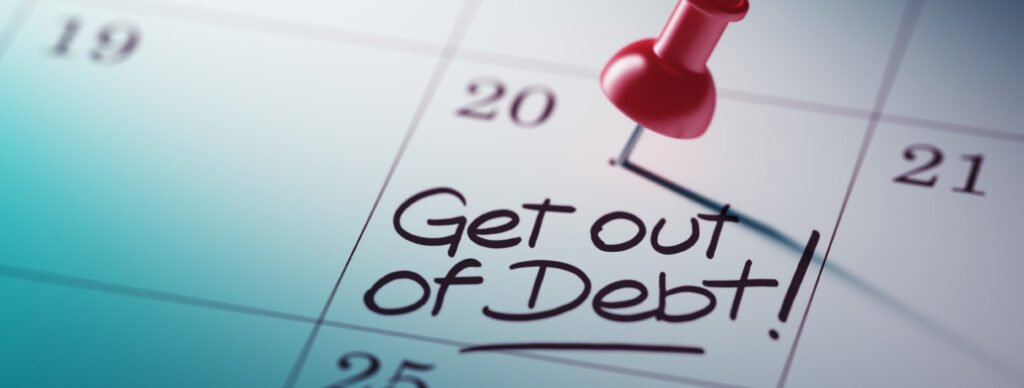“The borrower is slave to the lender.” – Proverbs 22:7
Debt can feel like quicksand. The more you struggle without direction, the deeper you sink. But with the right mindset and plan, anyone — yes, anyone — can climb out.
Why Getting Out of Debt Matters
Living with debt is exhausting — mentally, emotionally, and financially. It:
- Eats up your monthly income through EMIs and interest
- Keeps you from saving or investing
- Causes stress and anxiety
- Affects your credit score and future financial freedom
Whether it’s a personal loan, credit card debt, EMIs, or BNPL (Buy Now Pay Later) bills — it’s time to take control.
Types of Debt You Might Be Dealing With
1. Credit Card Debt
High-interest (30%–42% annually). Easily snowballs if you only pay the minimum due.
2. Personal Loans
Fixed EMIs with moderate to high interest (10%–24%). Tenure typically 1–5 years.
3. BNPL / Pay Later Apps
Apps like LazyPay, Simpl, Slice, Amazon Pay Later. Delayed payments lead to late fees and credit score damage.
4. Home Loans / Car Loans
Lower interest (7%–10%). Long tenures. Not always “bad” debt but still a monthly burden.
Step 1: Get Clarity — List All Your Debts
You cannot fix what you don’t face. Create a simple debt tracker. List:
- Type of debt (credit card, loan, etc.)
- Total outstanding amount
- Interest rate
- Minimum monthly payment
- Due date
- Lender
| Debt Type | Lender | Amount Owed | Interest Rate | EMI/Min Due | Due Date |
|---|---|---|---|---|---|
| Credit Card | HDFC | ₹55,000 | 42% | ₹5,500 | 5th |
| Personal Loan | Bajaj | ₹1,20,000 | 18% | ₹4,200 | 10th |
| BNPL | LazyPay | ₹7,000 | 36% | ₹3,000 | 2nd |
Step 2: Stop Taking New Debt Immediately
- Avoid “0% EMI” traps unless absolutely needed
- Disable credit cards or leave them at home
- Delete BNPL and loan apps from your phone
- Say no to lifestyle upgrades until you’re debt-free
“You can’t get out of a hole by digging deeper.”
Step 3: Prioritize — Use the Snowball or Avalanche Method
Option 1: Debt Snowball (Emotional win)
Pay off the smallest debt first (regardless of interest rate). Boosts motivation as you get quick wins.
Option 2: Debt Avalanche (Financially smart)
Pay off the highest interest debt first (like credit cards). Saves more on interest in the long run.
Pick one method and stick to it.
Step 4: Create a Bare-Bones Budget
To repay debt, you need a monthly surplus. Cut all non-essential expenses for 6–12 months.
Must-Haves:
- Rent
- Food and groceries
- Utilities (electricity, internet)
- EMIs
Cut or Reduce:
- Food delivery, subscriptions
- Weekend trips, impulse shopping
- Gadgets and upgrades
“Live like no one else today, so you can live like no one else tomorrow.” – Dave Ramsey
Step 5: Increase Your Monthly Payments
The minimum due keeps you in debt forever. Aim to pay at least 1.5–2x your EMI or minimum due where possible.
Ways to increase payments:
- Bonuses or tax refunds
- Freelance or weekend gigs
- Sell unused items
- Cut luxuries temporarily
Every extra rupee reduces your interest.
Step 6: Negotiate Lower Interest or Restructure
Contact your lender and ask for:
- Lower interest rate
- Waiver on late fees
- EMI restructuring or loan consolidation
If you’ve lost income or have a long repayment history, many banks may offer One-Time Settlements (OTS) or balance transfers.
Step 7: Automate Your Payments
Missing payments = penalties + credit score drop.
- Set auto-debit for EMIs and dues
- Set reminders 5–7 days before due dates
Step 8: Track Your Progress Monthly
Use a notebook or Excel sheet to:
- Track every payment
- Update your outstanding amounts
- Celebrate small wins when you clear each debt
Step 9: Build an Emergency Fund (Even While in Debt)
Start with ₹5,000–₹10,000 in a separate account. Build it up to cover 1–2 months of expenses.
Use it only for emergencies like medical bills, job loss, or urgent needs — not sales or gadgets.
Step 10: Stay Out of Debt for Good
- Don’t close your oldest credit card — it helps your credit score
- Use credit cards only if you can pay in full every month
- Continue budgeting even as income grows
- Build long-term savings and investments
“Debt is normal. Be weird.” – Dave Ramsey
Final Thoughts: You Can Do This
Beating debt is not about how much you earn — it’s about commitment and a clear plan. It’s okay to make mistakes. What matters is that you’ve decided to take control.
You won’t get out of debt overnight — but with discipline, you’ll be shocked how quickly you can make progress.
Debt-Free Success Story
Priya, 32, a schoolteacher in Pune, had ₹3.2 lakh in personal loans and credit card dues. She:
- Used the debt snowball method
- Tutored on weekends
- Cut expenses for 12 months
She cleared all her debt in 18 months and now saves 30% of her salary every month.
You can do it too.
Free Resources You Can Use
- CRED, OneScore — to track your credit score
- Notion / Excel templates — for budget planning
- Walnut, Money View — to track expenses
- RBI’s Financial Literacy Website
Need Help? Reach Out
If you’re struggling or don’t know where to start, email me at myfirstlakh@gmail.com or DM me on Instagram @myfirstlakh. I’ve been there. I know what it feels like. You’re not alone.


1 Comment
Pingback: How the Stock Market Works — For Beginners – MyFirstLakh